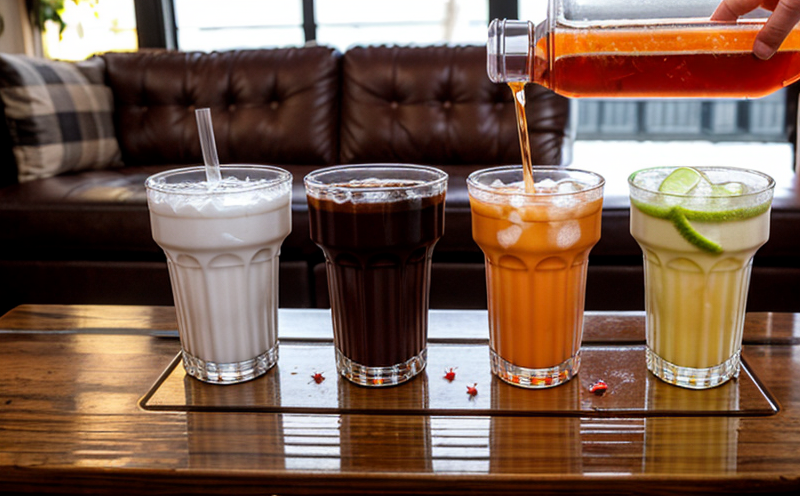EN 14150 Esters Determination in Alcoholic Beverages
The determination of esters in alcoholic beverages is a critical quality control process that ensures consistent and high-quality products. This method, specified by EN 14150, is widely used to quantify volatile organic compounds (VOCs) such as ethyl acetate, isoamyl acetate, and other esters present in various alcoholic drinks.
The importance of this test lies in its ability to assess the aroma profile of beverages. Esters contribute significantly to the bouquet and flavor complexity of spirits, wines, and beers. This is why accurate quantification via EN 14150 ensures that products meet consumer expectations and comply with quality standards.
Our laboratory adheres strictly to this European standard to deliver precise results. The method involves sample preparation followed by gas chromatography for the separation and detection of esters. The process requires meticulous attention to detail, including proper sampling techniques to avoid contamination and accurate calibration of instruments.
The testing procedure includes several critical steps:
- Sample dilution if necessary
- Heating under reflux conditions to release esters into the headspace
- Injection of the headspace gas into a gas chromatograph equipped with a flame ionization detector (FID)
- Data analysis using peak integration and comparison against calibration standards
The results provide insights into the overall quality of alcoholic beverages, helping manufacturers to adjust their formulations for improved taste profiles.
Our expertise in this area allows us to offer reliable data that can be used by R&D teams to innovate new products or refine existing ones. Quality managers and compliance officers will find our services invaluable as they ensure product consistency across batches and markets.
| Sample Preparation | Instrumentation Used | Key Parameters |
|---|---|---|
| Dilution of samples if necessary | Gas Chromatograph (GC) | Volatile Organic Compounds (VOCs) analysis |
| Heating under reflux conditions | FID detector for VOCs | Peak integration for quantification |
| Injection of headspace gas into GC | Calibration standards | Data analysis and comparison |
The precision and accuracy achieved through our EN 14150 testing align us with international quality benchmarks, ensuring that our clients meet both regulatory and consumer expectations.
We offer comprehensive services beyond just compliance. Our team of experts can assist in optimizing production processes to enhance flavor profiles or troubleshoot issues related to off-flavors. This service is especially beneficial for R&D engineers looking to innovate within the beverage sector.
Why It Matters
The importance of ester determination cannot be overstated, particularly in the context of alcoholic beverages where flavor and aroma are paramount. Esters play a crucial role in defining the character of spirits, wines, and beers. They contribute to the complexity and depth of flavors that consumers expect from their favorite drinks.
- Enhances product quality: Ensures consistent taste profiles across batches
- Facilitates compliance: Meets regulatory standards for alcoholic beverages
- Safeguards reputation: Protects brand integrity by maintaining high-quality standards
- Informs innovation: Provides data to R&D teams for new product development or process improvements
The results from our EN 14150 testing are essential for manufacturers to maintain a competitive edge in the market. By adhering strictly to this European standard, we ensure that all tests performed meet high scientific and technical standards.
Our services extend beyond simple compliance; they provide valuable insights that can drive business growth by enhancing product quality and innovation capabilities.
Applied Standards
The EN 14150 standard for the determination of esters in alcoholic beverages is widely recognized across Europe. This international standard specifies a precise method to quantify volatile organic compounds (VOCs) using gas chromatography with a flame ionization detector (GC-FID).
Compliance with this standard ensures that all tests conducted by our laboratory meet stringent quality and accuracy criteria. The following sections outline the key aspects of EN 14150:
- Sample Preparation: Dilution if necessary, heating under reflux conditions for VOC release.
- Instrumentation: Gas Chromatograph equipped with a FID detector.
- Data Analysis: Peak integration and comparison against calibration standards.
The standard also includes detailed instructions on how to handle samples, prepare calibration solutions, and interpret results. This ensures that all measurements are conducted in a consistent manner, leading to reliable and reproducible outcomes.
Our laboratory is committed to adhering strictly to these guidelines, ensuring that every test performed aligns with the highest scientific and technical standards. By doing so, we provide clients with confidence in their results and peace of mind knowing they meet all relevant regulatory requirements.
Use Cases and Application Examples
The application of EN 14150 is extensive and covers various scenarios within the beverage industry. Here are some real-world examples illustrating how this method can be used:
- Quality Control: Regular testing to ensure consistent flavor profiles across different batches.
- New Product Development: Flavor profiling of new products or modifications to existing ones.
- Process Optimization: Identification and resolution of issues related to off-flavors by adjusting production parameters.
The table below provides a detailed overview of the application scenarios:
| Application Scenario | Description |
|---|---|
| Quality Control | Regular testing to ensure consistent flavor profiles across different batches. |
| New Product Development | Flavor profiling of new products or modifications to existing ones. |
| Process Optimization | Identification and resolution of issues related to off-flavors by adjusting production parameters. |
In addition to these use cases, the method is also employed in research and development activities aimed at enhancing product quality. For instance, R&D engineers can leverage EN 14150 data to innovate new products or refine existing ones.
The versatility of this standard makes it indispensable for any organization involved in the production of alcoholic beverages. By adhering to EN 14150, companies not only meet regulatory requirements but also enhance their reputation and competitiveness in the market.





